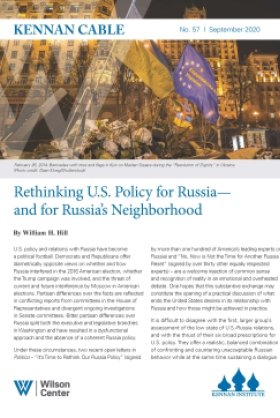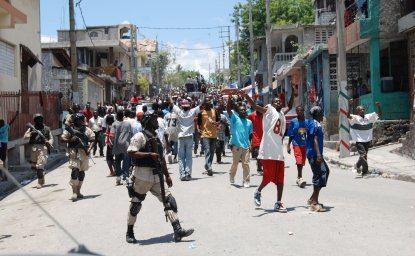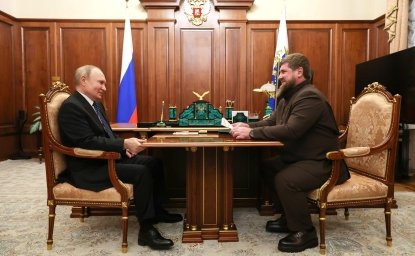Kennan Cable No. 57: Rethinking US Policy for Russia – and for Russia’s Neighborhood


US policy and relations with Russia have become a political football. Democrats and Republicans offer diametrically opposite views on whether and how Russia interfered in the 2016 American election, whether the Trump campaign was involved, and the threat of current and future interference by Moscow in American elections. Partisan differences over the facts are reflected in conflicting reports from committees in the House of Representatives and divergent ongoing investigations in Senate committees. Bitter partisan differences over Russia split both the executive and legislative branches in Washington and have resulted in a dysfunctional approach and the absence of a coherent Russia policy.
Under these circumstances, two recent open letters in Politico – “It’s Time to Rethink Our Russia Policy” (signed by more than one hundred of America’s leading experts on Russia) and “No, Now is Not the Time for Another Russia Reset” (signed by over thirty other equally respected experts) – are a welcome injection of common sense and recognition of reality in an emotional and overheated debate. One hopes that this substantive exchange may constitute the opening of a practical discussion of what ends the United States desires in its relationship with Russia and how those might be achieved in practice.
It is difficult to disagree with the first, larger group’s assessment of the low state of US-Russia relations, and with the thrust of their six broad prescriptions for US policy. They offer a realistic, balanced combination of confronting and countering unacceptable Russian behavior while at the same time sustaining a dialogue aimed at preventing misunderstandings and pursuing mutually acceptable solutions to common problems. It is especially vital to underline the observation in the letter that engagement and dialogue with Moscow is not a reward that should be denied as a response to actions which we dislike. It is in times of severe disagreement that diplomatic contacts are most needed.
I believe the critics of the first letter have more in common with their counterparts than the sharp wording of their response might suggest. The critics quite rightly point out that dialogue cannot succeed without substantive, constructive responses from Moscow, which often have not been forthcoming. They also underscore the importance of defending values and norms in international behavior which are crucial to the well-being and integrity of our domestic system. Finally, as the signatories note, it is not entirely clear whether the US needs a different Russia policy, or just a coherent, unconfused, non-contradictory policy. This is a discussion which needs to be developed further and reflected in the formulation of US policy toward Russia, irrespective of the administration in office next year.
Yet the main, continuing obstacle to improving US-Russia relations does not receive adequate acknowledgement in either of these open letters. Russia’s relations with the former Soviet republics, now independent states and its immediate neighbors, will likely remain a major source of disagreement between Washington and Moscow. This region holds a special importance for Russia; few western policymakers grasp the depth of Moscow’s attachment. The West views these neighboring states as independent, sovereign nations. Russia accepts their independence so long as it does not contradict Russian interests. These factors make reaching agreements on the conflict in Ukraine acceptable to both Russia and the US significantly more difficult than for other regional issues, such as, for example, Syria or Libya. For the same reasons, disputes over Western involvement in states like Ukraine are more likely to disrupt the entire spectrum of bilateral relations with Moscow than more distant regional disputes.
Disputed Sovereignty
When the Soviet Union fell apart in December 1991, the United States recognized the Russian Federation and the other fourteen former Soviet republics as independent, fully sovereign countries. US policy, and that of most of our allies since that time, has adhered to this principled approach. From the moment of the Soviet collapse, Russia has followed a somewhat different line. Moscow indeed quickly recognized the independence of the other fourteen former Soviet republics. But even during the Yeltsin administration, when relations were closest between Washington and Moscow, Russia sought to assert special relationships and special interests with these post-Soviet neighbors. Many Russians call these states the “post-Soviet space” or the “near abroad” (blizhnoe zarubezh’e). Citizens of these states often find these terms offensive, as they are taken to suggest that their countries are something less than fully independent and sovereign. In August 2008, then President Dmitri Medvedev made explicit this Russian approach to its neighbors when he asserted that Georgia was part of a region of Russia’s “privileged interests.”
From the very beginning, Yeltsin attempted to preserve elements of Russia’s presence, influence, and control in other former Soviet republics through the Commonwealth of Independent States (CIS). Moscow proposed to preserve common armed forces and border controls. With a couple of exceptions, most of the newly independent states spurned Moscow’s efforts at closer integration through the CIS. Similarly, Russia proposed a collective security treaty of the former Soviet states, which was signed in Tashkent in May 1992. Not all signed on, and those that did generally avoided substantial military or political integration in the Collective Security Treaty Organization formally established on the basis of the treaty ten years later.
Conflicts that arose during the Soviet collapse in and between states around Russia’s periphery provided Moscow another means of maintaining its presence and influence. In Georgia, ethnic conflict broke out in South Ossetia and Abkhazia. In Moldova, pro-Soviet (and later pro-Russian) elites in the Transdniestrian region resisted the push by Chisinau, Moldova’s capital, for independence from Moscow. Russian troops remaining in Georgia and Moldova from the Soviet era participated in the fighting and eventually were designated peacekeeping forces. Russia became a mediator in political settlement negotiations for all three conflicts. The origins of Russian troops in Georgia and Moldova today is a complicated subject, which is often oversimplified, in part in efforts to explain the history briefly.
Russia also helped broker a ceasefire in 1994 in a war between Armenia and Azerbaijan over the latter’s Nagorno-Karabakh region, populated largely by ethnic Armenians. Russia remains one of the three Co-Chairs of the OSCE’s Minsk Group, dedicated to finding a settlement to that conflict. Russian diplomats and troops were also instrumental in finding a resolution to a protracted civil war in Tajikistan.
On its western flank, Moscow inherited a substantial Soviet troop presence in the Baltics, Lithuania, Latvia, and Estonia when the USSR collapsed. With a combination of Western pressure and incentives, Moscow withdrew all of these military forces by the end of 1994, although ongoing issues remained with a couple of major military facilities and the status of Soviet military pensioners still residing in the Baltics. Moscow also continued to have substantial disagreements with Tallinn and Riga over the citizenship and residency status of ethnic Russians remaining in Latvia and Estonia.
Ukraine was always a special case for Russia. Crimea and eastern and southern Ukraine contain a high percentage of ethnic Russians and Russian speakers with a Russian majority in Crimea. The Russian military retained the Black Sea Fleet, headquartered in Sevastopol in Crimea, and the Russian military-industrial complex remained closely integrated with major industrial facilities in Ukraine, particularly in the east. Crimea’s population voted narrowly in late 1991 to remain in independent Ukraine, but there was always considerable appeal among the local population, often fanned by Russian politicians such as Moscow’s Mayor Iurii Luzhkov, for Crimea to leave Ukraine and join Russia.
Russian-Ukrainian relations grew increasingly tense during the first five years after the Soviet collapse. The US was instrumental in convincing Ukraine to give up its nuclear weapons and delivery systems, a decision cemented by the 1994 Budapest Memorandum. In return, Ukraine received security assurances from the United States, United Kingdom, and Russia. In early 1997, as NATO prepared to make the decision on its first enlargement and Kyiv approached agreement on a special relationship with NATO, Yeltsin finally normalized relations with Ukraine and signed a fifteen-year pact allowing Russia to base its Black Sea Fleet in Crimea. Ties between Moscow and Kyiv have repeatedly warmed and cooled in the 23 years since then.
During the first post-Soviet decade, the Russian and US positions on and policies toward Moscow’s post-Soviet neighbors were never fully in alignment, and open disagreements were not uncommon. However, these disagreements never became serious enough to threaten the cooperative relations between the top leaders of both countries. For example, friendly relations between Presidents Clinton and Yeltsin directly or indirectly led to US support in the UN for Russian peacekeepers in Abkhazia (UNOMIG), in return (as some alleged) for Moscow’s support for the US operation in Haiti. Washington supported Moldovan independence and territorial integrity but tacitly backed Russian Foreign Minister Primakov’s 1997 Moscow Memorandum initiative to settle the Transdniestrian conflict.
During the 2000s, NATO enlargement, EU expansion, and the global war on terror all contributed to much more extensive and deeper involvement and presence by the US and our allies in the former Soviet states on Russia’s borders. American troops were sent to Georgia to help train and equip anti-terror efforts. US democracy promoters offered support for “color revolutions” in Georgia, Ukraine, and Kyrgyzstan in 2003-2005. The US helped thwart a unilateral Russian effort to include a long-term troop presence as part of a unilateral peace deal in Moldova. NATO promises in April 2008 of eventual membership to Ukraine and Georgia preceded the August Russia-Georgia War and Moscow’s recognition of the independence of Abkhazia and South Ossetia. In less than a decade, the states bordering Russia had gone from a region of intermittent cooperation and disagreement to one of outright confrontation between Washington and Moscow.
The Obama Administration’s reset of relations with Russia produced a number of significant successes – New START, a civilian nuclear agreement, the Northern Distribution Network to assist and supply the American-led coalition fighting in Afghanistan, among others. However, the reset did not resolve the fundamental disagreement between the US and Russia over the nature of, and potential limitations on the sovereignty and independence of the states bordering Russia. Putin stepped up his efforts to build Eurasian integration projects such as the Eurasian Economic Union (EaEU) to counter NATO, EU, and American/Western influence. Moscow’s disagreement was not just with Washington; the Ukraine crisis of 2013-2014 grew out of Russia’s refusal to countenance a deeper Ukrainian relationship with the European Union and concomitant loss of Russian influence.
The Ukrainian crisis of 2013-2014, the Russian annexation of Crimea, and the ongoing war in the Donbas are especially serious and hard to resolve because they constitute (especially Crimea) an unambiguous, direct violation of the security and political agreements by which the states of the European/Euro-Atlantic region lived from 1945 to 2014. The 1975 Helsinki Final Act, which in essence served as the European treaty ending World War II, expressly disavowed changing borders by force. While military actions had taken place within states in Europe during that period, the Russian seizure of Crimea in 2014 was the first instance of invasion and territorial conquest in Europe since the early 1940s.
Russia’s actions in Ukraine are threatening not only because they have called into doubt agreements and norms which have governed the behavior of states in Europe for the past half century or more. These actions also make manifest Moscow’s continuing basic understanding of its interests and rights in many of the states that border it. As such, given certain circumstances, Moscow is prone, perhaps even likely to repeat such actions. Russia seems unlikely to have ambitions or plans to invade central or western Europe, Scandinavia, or (more of) the Black Sea littoral. However, certain states on or near Russia’s border – in particular the so-called “states in-between,” Belarus, Ukraine, Moldova, Georgia, Armenia, and Azerbaijan – by most indications remain part of Moscow’s perceived, self-proclaimed sphere of “privileged interests.” In the last decade and a half, Moscow has shown itself ready to apply military force in two of those states when it perceived its interests to be threatened. There is little public evidence to indicate that this attitude has changed.
None of this should be taken as a rejection of the basic proposition that dialogue with Russia is necessary and cooperation warranted when in our mutual interests. Instead, we must be clear where the most intractable, serious disagreement between Moscow and Washington is likely to persist, and where some of the most dangerous possibilities for misunderstanding may arise.
Most of the areas of conflict or discord between the US and Russia listed in the open letters are susceptible to compromise of some sort, or at least a modus vivendi. Our respective positions on the status of Russia’s neighbors are, on the other hand, incompatible in principle. It is hard to see how one reconciles support for full independence and sovereignty, on the one hand, and a self-asserted “privileged interest” on the other.
US and Western policy in the “states in-between” thus requires both a nuanced, pragmatic approach and a deep understanding of the particular circumstances on the ground in each state. Experience shows that Moscow can be prone to interpret support for open societies and democratic practices (such as competitive elections), or expansion of economic and political presence, as a threat to Russia’s interests, sometimes as a threat to Russia itself—and act accordingly. At the same time, some in the West are inclined to view every attempt by Moscow to broaden its ties with these states or support ethnic Russian and Russian-speaking populations as part of a campaign of political coercion and territorial aggrandizement. Some of Moscow’s actions have made it difficult to dissuade those who hold this latter view.
The fact remains that Russia has interests in these countries. We in the US disagree with some of the ways in which Moscow defines these interests, and especially with some of the ways in which it pursues them. At the same time, the reality is that Russia is a large state, which borders on a number of smaller states. Throughout history Russia has tended to impose its will and interests on these smaller states, a fact which to a considerable degree explains the suspicious, often hostile attitude toward Russia of the peoples on its borders. These historical memories and animosities do not constitute inescapable destiny, but they do form the political and diplomatic context in which US diplomatic representatives will operate for the foreseeable future.
Conflict between Russia and the US over the countries “in-between” is not inevitable; in fact, even during the most trying times after the Russian annexation of Crimea, Russian and American diplomats worked together with surprising comity and cooperation in addressing the conflicts in Moldova and between Azerbaijan and Armenia. As two of the three Co-Chairs of the settlement negotiations between Armenia and Azerbaijan, American and Russian representatives have reached common positions, proposed common initiatives, and maintained decent working relations despite the geopolitical rivalries seeming to dominate the bilateral relationship. In Moldova from 2015 on, Russian and American diplomats participated cooperatively and effectively in a multilateral effort through the OSCE which has resolved many of the practical obstacles to settlement between Moldova and its breakaway Transdniestrian region. These are relatively small, circumscribed issues, but nonetheless important indicators that, given the right circumstances and approaches, relations and conditions can be improved.
So how should the US and the incoming/returning administration approach this most sensitive, difficult issue of principled disagreement with Russia? The following suggestions might help:
- Make discussion of the “states in-between” a regular agenda item of discussion at the senior working level between US and Russia. This is a way to flag, explain, and seek to understand those actions, activities, or policies of the other side which seem provocative or worrisome. This practice has a precedent in US-Soviet discussion during the latter years of the Cold War.
- In these discussions, be up-front with Russian representatives about our disagreements in principle with their policies or actions, especially those which seek to limit the independence or sovereignty of these states. At the same time, we must indicate our commitment to settling these differences peacefully, through negotiation and mutually acceptable and mutually agreed actions.
- Use, and adapt if necessary, existing mechanisms such as the OSCE’s 2011 Vienna Document on Confidence and Security-Building Measures (the one remaining conventional arms control agreement in Europe) to address security issues, transparency, and confidence-building in this region. The structured dialogue introduced not too long ago in the OSCE would be one especially appropriate forum for multilateral discussion of our concerns for security and stability in the region.
- Be wary of over-promising to those states with whom our relations are good or of entering into a bidding war with Moscow in those states where there may seem to be a competition. Be especially wary of US support or assistance being drawn into domestic political competitions or disputes.
- Develop and nurture US expertise in the region and these countries. Although Russia’s often overwhelming presence is a factor in the domestic politics and international relations of all these states, conditions, histories, and actors vary enormously among them. We often overestimate Moscow’s influence and underestimate that of local actors.
- Launch and conduct an ongoing internal US policy dialogue on how best Washington can promote the independence, sovereignty, and security of these in-between states, while avoiding outright conflict with Russia. There is no one answer to this question, but recent experience in Georgia and Ukraine suggests there are limits to how far we are willing to go, particularly in risking military confrontation.
- Declaring a position of principle, and then engaging in “strategic waiting” is not the best solution, but also not always the worst. The US supported the independence of the Baltic states for almost fifty years before they finally left the Soviet Union in 1991. A similar wait (one hopes not so long) may be necessary if Crimea is to be returned to Ukraine.
- NATO membership for Ukraine and Georgia is likely to be part of a broader strategic dialogue with Russia over the scope and military posture of the Alliance. For practical purposes, the best approach for the moment is probably expressed in the phrase coined by one former US diplomat: “Not now, but not never.”
This discussion and these suggestions address what has been and is likely to remain a particularly sensitive and difficult subject area of our relations and dialogue with Russia. Our differences and disagreements over Russia’s approach and actions in the states in-between are likely to persist for the foreseeable future; as the authors of the first open letter state, these are not just Putin’s, but Russia’s positions. The suggestions in this essay can help the US avoid confrontation and open conflict in the region most sensitive for Russia, where the actions of all parties may be particularly susceptible to misinterpretation.
Overall, it has taken some time for US-Russia relations to deteriorate to their present low level, and it will take time, patience, and flexibility to restore them. The independence, sovereignty, security, and stability of the states on Russia’s borders are both important issues of principle but also practical ends that must be pursued and protected in the current, unfavorable broader political context of Russia’s relations with the West. We in the US need not, and must not lose sight of our principles, but – as I wrote some ten years ago:
“… Russia’s suspicious, hostile manner of perceiving and responding to western involvement in the near abroad is fully developed and deeply entrenched …, and will likely remain exceptionally difficult to challenge or to change. Even if sore points such as NATO expansion and missile defense in Europe are successfully resolved, Moscow’s extreme sensitivity to perceived geopolitical challenges in its immediate neighborhood will continue to pose a formidable challenge to real partnership and cooperation between Russia and its former Cold War adversaries. For improvement on this score depends not so much on changes in western understanding and behavior – no matter how necessary and desirable these may be – but on fundamental change in how the Russian political elite perceives and acts upon the world around it, a far less predictable and lengthier historical process.”[1]
Russia’s annexation of Crimea and support for the separatist war in the Donbas are direct consequences of Western and Russian fundamentally different view of the status of the “states in between.” How these opposing sides have handled this disagreement in recent years constitutes one of the primary obstacles to building a constructive relationship with Russia. We must try, but we should not delude ourselves with expectations of quick or easy improvement. It will take time, consistency, patience, and persistence—but first among these understanding of the source and scale of these divergent viewpoints.
[1] William H. Hill, Russia, the Near Abroad, and the West: Lessons from the Moldova-Transdniestria Conflict (Woodrow Wilson Center Press, Washington D.C., 2012), p. 184.
Author

Former Professor of National Security Strategy, National War College, Washington D.C.

Kennan Institute
After more than 50 years as a vital part of the Wilson Center legacy, the Kennan Institute has become an independent think tank. You can find the current website for the Kennan Institute at kennaninstitute.org. Please look for future announcements about partnership activities between the Wilson Center and the Kennan Institute at Wilson Center Press Room. The Kennan Institute is the premier US center for advanced research on Eurasia and the oldest and largest regional program at the Woodrow Wilson International Center for Scholars. The Kennan Institute is committed to improving American understanding of Russia, Ukraine, Central Asia, the South Caucasus, and the surrounding region through research and exchange. Read more




